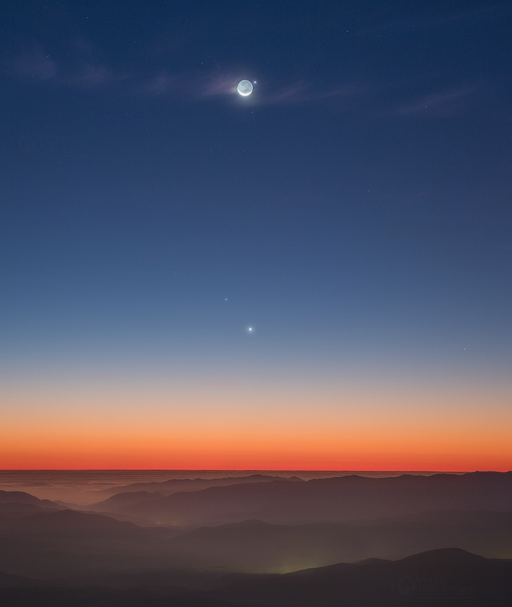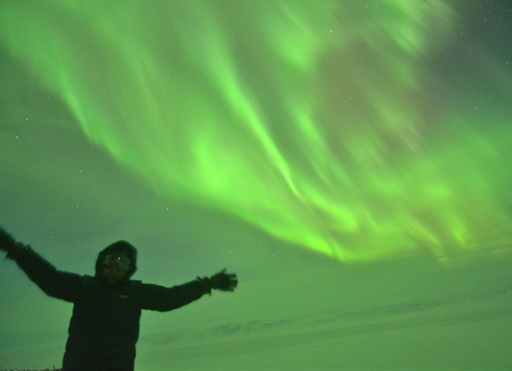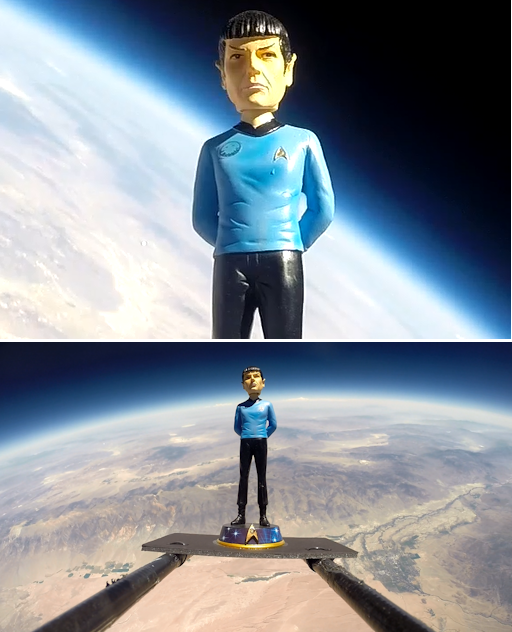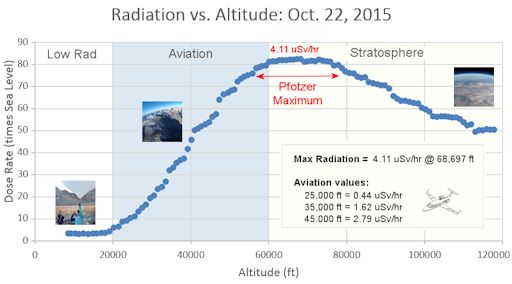Directly under the Arctic Circle! Marianne's Arctic Xpress in Tromsø offers fjord, whale and wildlife tours by day, aurora tours by night. Book Now and get a 10% discount on combo day and night adventures. | | | SUNSET PLANETS: When the sun goes down tonight, Aug. 5th, step outside and look west. Jupiter and the slender crescent Moon are having a close encounter only ~1 degree apart. Try to catch them before the sky fades to black. A bright conjunction framed by deep twilight blue is a wonderful sight, indeed. [sky map] In a preview of tonight's conjunction, on Aug.4th photographer Yuri Beletsky caught the crescent Moon passing by Mercury en route to Jupiter above Chile's Atacama desert: 
"We were so lucky to witness a truly amazing scene - Moon and Mercury in close dance just above bright Venus soon after the sunset," says Beletsky. Realtime Space Weather Photo Gallery ANTARCTIC LIGHTS: For the third day in a row, Earth is inside a fast-moving stream of solar wind. This has caused almost non-stop auroras over Antarctica. Gabriel Saiquita sends this self-portrait from Argentina's Belgrano II research station at latitude -78° S: 
"Las auroras fueron muy grandes por un momento (hace un tiempo largo que no tuvimos auroras como estas) y logre tomar estas increibles fotos," says Saiquita. Observers at the Maitri Indian Research Base on the Schirmacher oasis and the Bharati Indian Base Station in the Larsemann Hills have also reported spectacular lights. NOAA forecasters say there is a 40% chance of G1-class geomagnetic storms on Aug. 5th as the solar wind speed continues to run high. Antarctic sky watchers--all ~1000 of them--should remain alert for auroras. Aurora alerts: text or voice Realtime Aurora Photo Gallery GREEN-BLOODED BOBBLEHEAD: The 50th Anniversary of Star Trek is now. To celebrate (and to support their crowdfunded research program) the students of Earth to Sky Calculus flew the pointy-eared science officer to the stratosphere on July 24, 2016. Here he is at the apex of the flight, more than 32.2 km (112,200 ft) above Earth's surface: 
You can buy this collector's item for only $129.95 in the in the Earth to Sky Store. Proceeds from the sale support space weather research. Bobblehead Spock hitchhiked on a helium balloon payload that carried an array of X-ray/gamma-ray sensors. By launching these sensors 3 or 4 times a month, the students have shown that cosmic rays are intensifying--a trend that affects mountain climbers, air travelers, high-altitude drones, and astronauts on the International Space Station.
Realtime Noctilucent Cloud Photo Gallery
Realtime Sprite Photo Gallery Every night, a network of NASA all-sky cameras scans the skies above the United States for meteoritic fireballs. Automated software maintained by NASA's Meteoroid Environment Office calculates their orbits, velocity, penetration depth in Earth's atmosphere and many other characteristics. Daily results are presented here on Spaceweather.com. On Aug. 5, 2016, the network reported 102 fireballs.
(70 sporadics, 27 Perseids, 3 Southern delta Aquariids, 1 Northern delta Aquariid, 1)  In this diagram of the inner solar system, all of the fireball orbits intersect at a single point--Earth. The orbits are color-coded by velocity, from slow (red) to fast (blue). [Larger image] [movies] Potentially Hazardous Asteroids ( PHAs) are space rocks larger than approximately 100m that can come closer to Earth than 0.05 AU. None of the known PHAs is on a collision course with our planet, although astronomers are finding new ones all the time. On August 5, 2016 there were potentially hazardous asteroids. Notes: LD means "Lunar Distance." 1 LD = 384,401 km, the distance between Earth and the Moon. 1 LD also equals 0.00256 AU. MAG is the visual magnitude of the asteroid on the date of closest approach. | | Cosmic Rays in the Atmosphere | | Situation Report -- Oct. 30, 2015 | Stratospheric Radiation (+37o N) | | Cosmic ray levels are elevated (+6.1% above the Space Age median). The trend is flat. Cosmic ray levels have increased +0% in the past month. | | Sept. 06: 4.14 uSv/hr (414 uRad/hr) | | Sept. 12: 4.09 uSv/hr (409 uRad/hr) | | Sept. 23: 4.12 uSv/hr (412 uRad/hr) | | Sept. 25: 4.16 uSv/hr (416 uRad/hr) | | Sept. 27: 4.13 uSv/hr (413 uRad/hr) | | Oct. 11: 4.02 uSv/hr (402 uRad/hr) | | Oct. 22: 4.11 uSv/hr (411 uRad/hr) | These measurements are based on regular space weather balloon flights: learn more. Approximately once a week, Spaceweather.com and the students of Earth to Sky Calculus fly "space weather balloons" to the stratosphere over California. These balloons are equipped with radiation sensors that detect cosmic rays, a surprisingly "down to Earth" form of space weather. Cosmic rays can seed clouds, trigger lightning, and penetrate commercial airplanes. Our measurements show that someone flying back and forth across the continental USA, just once, can absorb as much ionizing radiation as 2 to 5 dental X-rays. For example, here is the data from a flight on Oct. 22, 2015: 
Radiation levels peak at the entrance to the stratosphere in a broad region called the "Pfotzer Maximum." This peak is named after physicist George Pfotzer who discovered it using balloons and Geiger tubes in the 1930s. Radiation levels there are more than 80x sea level. Note that the bottom of the Pfotzer Maximim is near 55,000 ft. This means that some high-flying aircraft are not far from the zone of maximum radiation. Indeed, according to the Oct 22th measurements, a plane flying at 45,000 feet is exposed to 2.79 uSv/hr. At that rate, a passenger would absorb about one dental X-ray's worth of radiation in about 5 hours. The radiation sensors onboard our helium balloons detect X-rays and gamma-rays in the energy range 10 keV to 20 MeV. These energies span the range of medical X-ray machines and airport security scanners. | | The official U.S. government space weather bureau | | | The first place to look for information about sundogs, pillars, rainbows and related phenomena. | | | Researchers call it a "Hubble for the sun." SDO is the most advanced solar observatory ever. | | | 3D views of the sun from NASA's Solar and Terrestrial Relations Observatory | | | Realtime and archival images of the Sun from SOHO. | | | from the NOAA Space Environment Center | | | the underlying science of space weather |  | Tobi -- Proud Supporter of Space Education! | | | a proud supporter of science education and Spaceweather.com |  | Claim your tax refund with this UK tax rebate company and get back your overpaid tax. |  | Enjoy this fabulous range of leather sofas from a leader in the UK sofa manufacturer industry.. | | 
